
Chana School is a Registered Historic Place in Ogle County, Illinois, in the county seat of Oregon, Illinois. One of six Oregon sites listed on the Register, the school is an oddly shaped, two-room schoolhouse which has been moved from its original location. Chana School joined the Register in 2005 as an education museum.

The Thomas Select School is a historic log building in rural Butler County, Ohio, United States. Constructed in 1810, the building has seen numerous uses, ranging from church to school to house. It has been named a historic site.

The Charter Oak Schoolhouse is a historic octagonal school building in Schuline, Illinois, located on the Evansville/Schuline Road between Schuline and Walsh. Built in 1873, it served as a public primary school until 1953. The school was one of 53 octagonal schoolhouses built in the United States, of which only three survive. The building is now used as a museum by the Randolph County Historical Society and is listed on the National Register of Historic Places.
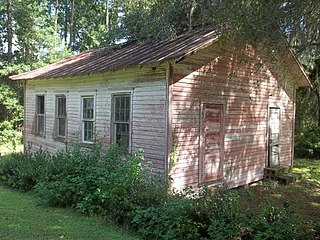
Liberty Hill Schoolhouse in Gainesville, Florida is a one-room schoolhouse that was built in 1892 to serve African-American children. It replaced a previous Liberty Hill School that was in operation by about 1869, and it operated until the 1950s.

The Lower Shell School House is located in an isolated portion of Big Horn County, Wyoming on a bluff near Shell Creek. The schoolhouse was built in 1903, and was one of the first buildings in the area that did not use log construction. The school functioned as a church and Sunday school, and as a community meeting place. It was used as a school until the 1950s, and as a community meeting house until the 1970s.

Carter Street Schoolhouse No. 21 is a historic one-room school building located at Orleans in Jefferson County, New York. It is a 1 1⁄2-story, rectangular limestone structure built about 1850. It was last used as a school in the 1930s.
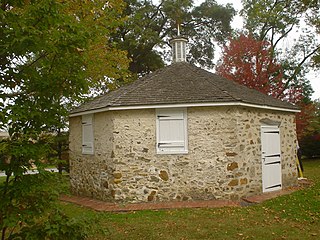
The Hood Octagonal School is a historic octagonal schoolhouse located in Newtown Square, Delaware County, Pennsylvania. It was built in 1841, and is a small, fieldstone, one-story, eight sided building with a wood shingled pyramidal roof. The school was abandoned about 1865, then restored in 1964.

Trinity African Methodist Episcopal Church is a historic church in Gouldtown, Fairfield Township, Cumberland County, New Jersey, United States. Gouldtown is now just a crossroads with a few buildings, but it is one of the oldest settlements in America founded by free, land-owning African-Americans. The Rev. Ruben Cuff of Salem County organized a society of African Americans in 1818. In 1823 they bought an unused schoolhouse to use as a church, and in 1834 they bought a second schoolhouse and moved it to the site.

Indian Rock Schoolhouse, also known as District 3 Schoolhouse or Webutuck Country Schoolhouse, is located on Mygatt Road in the hamlet of Amenia, New York, United States. It is a wooden one-room schoolhouse built in the mid-19th century in accordance with a standard state plan for small rural schools that reflected contemporary educational reform movements.
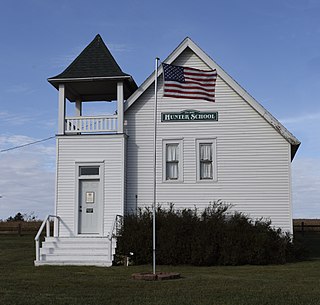
Hunter School is a historic building near Tabor, Iowa, United States. The one-room schoolhouse was built in 1901. The school was named for John H. Hunter, a farmer and landowner on whose property the original school was built in 1901. Its use as a schoolhouse came to an end in 1920 when it was consolidated into the Tabor School District. The building was used as a township meeting and a polling place until 1990. Since then it has been maintained as a historical landmark. The former schoolhouse is a frame structure built on a brick foundation, and consists of a 24-by-26-foot main block and an 8-foot (2.4 m) square bell tower-entrance. While the schoolhouse overall follows a basic plan for a one-room schoolhouse, it departs from that plan with the asymmetrically placed corner tower. It was added to the National Register of Historic Places in 2007.
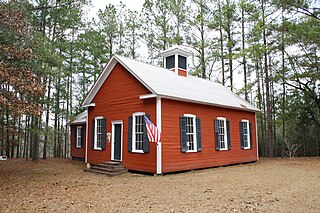
The Gainestown Schoolhouse is a historic school building on Clarke County Road 29 in Gainestown, Alabama. It was built in 1919 as a one-room schoolhouse and now serves as a guesthouse for the Wilson-Finlay House across the road. It was placed on the National Register of Historic Places on October 1, 1992, due to its architectural significance.

The Church Hill North Historic District is a historic district in Richmond, Virginia, that was listed on the National Register of Historic Places in 1997. An expansion of the district was listed in 2000. This added 37 acres (15 ha) to the original 70 acres (28 ha)

The Myers School near Shoshone, Idaho, United States, was a lava rock schoolhouse built in the 1910s probably by sheep rancher and stonemason Bill Darrah. It was listed on the National Register of Historic Places in 1983, when it was in deteriorated condition.

The Debs School, at 2783 McManus Rd. in Hinsdale County, Colorado, is a historic rural schoolhouse that was built in 1926. It has also been known as Upper Piedra School, 5HN642, and the Debs Community Building. It was listed on the National Register of Historic Places in 2005.

The Liberty Schoolhouse, also known as the Mt. Grove School, is a historic schoolhouse in a remote part of Ozark-St. Francis National Forest in Logan County, Arkansas. It is east of Corley, Arkansas, near the junction of Valentine Spring and Copper Spring Roads. It is a single-story vernacular wood-frame structure, with a gabled roof, weatherboard siding, and a foundation of concrete block piers. It was built in 1897, and was used by the community as both a school and church. It served as a school until 1944, and also hosted civic meetings and social events.

Mill Rock School is a historic one-room schoolhouse located south of Baldwin, Iowa, United States. It is one of over 217 limestone structures in Jackson County from the mid-19th century, of which 12 are school buildings. This school building was built in 1869 by Abner Hunt and P.A. Downer. The stone blocks that were used in the construction of this rectangular structure vary somewhat in shape and size, and they were laid in courses. The window sills and lintels are dressed stone. There is a brick chimney on the west elevation, and two entrance doors on the east elevation. Having two entrance doors is unusual for rural Jackson County schools. A name and date stone is located in the east gable.

Canton School is a historic one-room schoolhouse located in the unincorporated community of Canton, Iowa, United States. This school building was built in 1877 of locally quarried, roughly-dressed limestone, laid in a random ashlar pattern. The main facade, however, is faced with concrete brick that is original to the structure. What is unusual about this building is its decorative elements, as most one-room schoolhouses built in Iowa were plain. The eaves and the two-stage wooden bell tower are edged with rather delicate wooden trim, and the windows are capped with concrete keystone hoods. The use of concrete is rather sophisticated for a building in the vernacular-folk architectural style in stone. The building served as a school until 1966 when the area's school districts were reorganized. It served as a church until 1968, and it is now surrounded by a park.
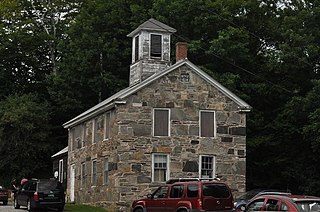
The South Reading Schoolhouse is a historic school building at Tyson and Bartley Roads in Reading, Vermont. Built in 1834, it is a distinctive example of the regional "snecked masonry" style, and the oldest known structure of the style to survive. It was used as a school until 1970, and was listed on the National Register of Historic Places in 1983.
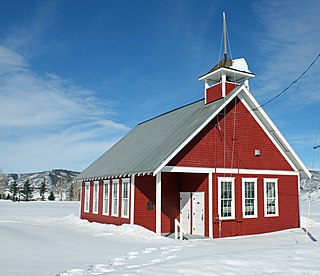
The Mesa Schoolhouse, near Steamboat Springs, Colorado, was built in 1916. It was listed on the National Register of Historic Places in 2007.

The Elsinore White Rock Schoolhouse, at 25 S. 100 East in Elsinore, Utah, was built in 1896. It was listed on the National Register of Historic Places in 1978.
























